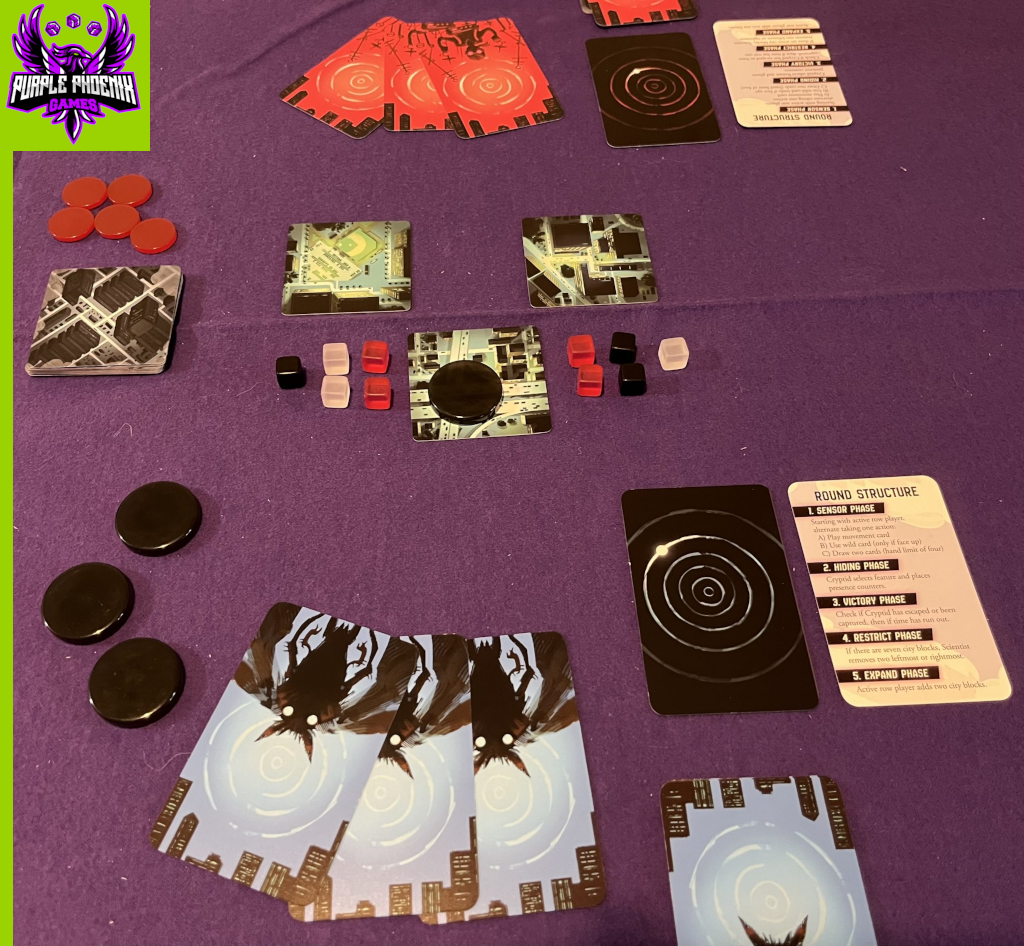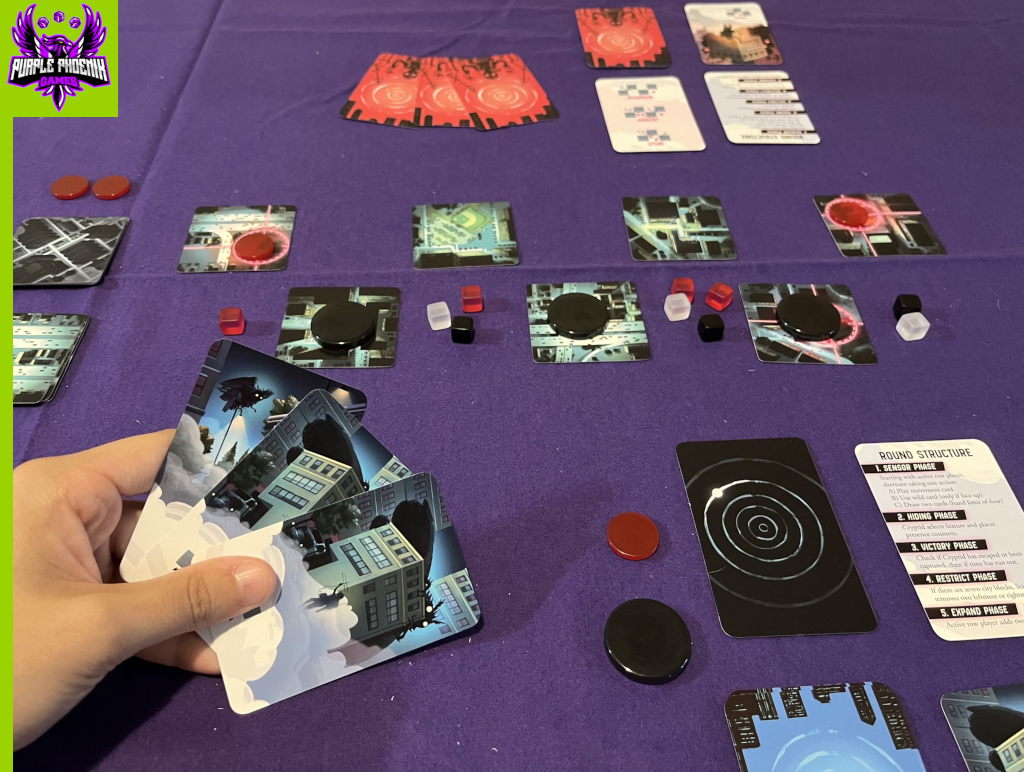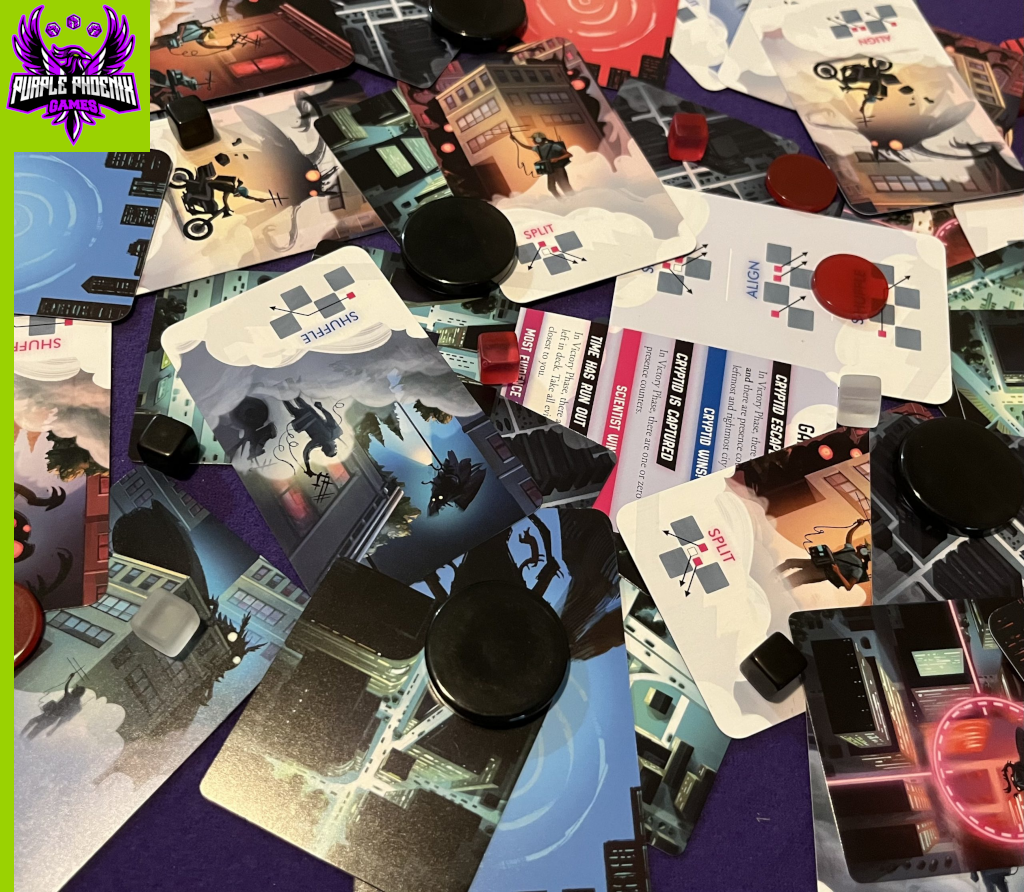
A while back, I was introduced to Cryptid and really enjoyed it. Trying to deduce your opponents’ clues while not giving away too much information about your own? Racing to find the location of the Cryptid through pattern recognition and strategy? It’s an overall *chef’s kiss* from me. So when I heard about Cryptid: Urban Legends, I was intrigued. An abstract and asymmetrical deduction game for only 2 players from the same designers as the original Cryptid? I was sold! I picked it up the first time I saw it on the shelf at a FLGS, and was keen to play. But how does it compare to the OG?
| Cryptid: Urban Legends (2022) | Osprey Games |
| 2 players | 20-40 minutes |
| Ages 14+ | BGG Weight – 2.50 / 5 |
Cryptid: Urban Legends is an asymmetrical game of abstract strategy for 2 players in direct competition with each other. One player will take on the role of the Cryptid, prowling through the city and attempting to avoid detection. The other will act as the Scientist, whose goal is to track down the Cryptid, thus bringing definitive proof to the world of its existence! To setup for a game, each player chooses their role and collects their corresponding deck of Movement cards. Create the deck of City Blocks accordingly and set 3 face-up in between the players to serve as the starting city. The deck of City Block cards is placed to the side, along with the Evidence Counters. Place the Sensor cubes next to the City Block as described in the rules, and place a Presence Counter on the City Block nearest the Cryptid, giving the remaining Presence Counters to the Cryptid player. The row closest to the Cryptid is considered the Active Row, and the other is the Inactive Row. Each player shuffles their deck of Movement cards and draws a starting hand of 3 cards. The game is now ready to begin! Pictured below is the setup for the game.

Played over a series of rounds, each player will be attempting to achieve their own unique goal in order to win the game. The Cryptid player wins if they have successfully placed a Presence Counter on the outer-most City Block cards in the Inactive Row, once there are 7 City Block cards in play. The Scientist wins if they are able to whittle the Cryptid player down to one or zero Presence Counters on City Blocks by the end of a round. If neither scenario has happened, but the deck of City Block cards has run out, the player who has collected the most Evidence Counters over the course of the game is declared the winner!
Each round is broken down into 5 phases: Sensor Phase, Hiding Phase, Victory Phase, Restrict Phase, and Expand Phase. The Cryptid player begins the game, playing first, and each subsequent round the starting player alternates between both players. In the Sensor Phase, players will be playing Movement cards from their hand in order to move the Sensor cubes from the Active Row to the available spaces in the Inactive Row of City Block cards. Sensors are placed between City Block cards, never on the cards. Players will select a card from their hand to play, and move the Sensors accordingly. Alternatively, a player may choose to draw 2 Movement from their deck, or use their Wild Card (when available). Movement cards allow you to move the Sensors in specific ways. For example, a Split action lets you move all Sensors from one space into either diagonally adjacent space in the Inactive Row – you choose how to divide them up. This phase continues until all Sensor cubes have been moved into the Inactive Row.
Next comes the Hiding Phase. Taking into account the new locations of the Sensor cubes, the Cryptid player will announce a ‘feature’ – either a number or a color combination. Once a feature is announced, only City Blocks in the Inactive Row with the exact number of Sensors/combination of colors in the spaces adjacent to it are considered to match. For each City Block that matches the announced feature, AND is diagonally adjacent to a Presence Counter in the Active Row, a new Presence Counter is placed on it. Any remaining Presence Counters are removed from the Active Row, and the round continues. The Victory Phase is the only phase in which the game can end. After the Hiding Phase is complete, players check to see if victory has been achieved by either player, thus ending the game. If victory has not yet happened, the game moves to the next phase – Restrict Phase. Once there are 7 City Block cards in play, during the Restrict Phase, the Scientist player will remove the left- or right-most 2 City Block cards from both Active and Inactive rows (one from each row). And finally, in the Expand Phase, the player closest to the Active Row draws two new City Block cards from the deck and adds them to outermost ends of the Active Row. The row that now has no Sensors in it (the Active Row for this round) is now the Inactive Row for the subsequent round, and vice versa.
A new round begins, and play continues as such – playing Movement cards, moving Sensors, announcing features, moving/adding/removing Presence Counters, and removing/adding new City Block cards – until one player has achieved their goal by the Victory Phase. That player is the winner!

As you can see from our rating graphic, Travis and I were not particularly impressed by this game. Having played the original Cryptid, we went into this one expecting a 2-player version of the original. Unfortunately, that’s not quite what we got. Beyond sharing the same name and designers, this game has few to no similarities to the original with which I fell in love. For starters, the rulebook itself was a little hard to decipher, and it took me several reads to feel like I had a firm grasp on the concept and gameplay. Even then, when teaching the game to Travis, we both felt like we had more questions than answers.
The actual gameplay? To me it feels very monotonous and limited, as there are so few components in play at a given time. All the players are doing is moving cubes between rows by utilizing a small hand of cards with only 3 overall movement options. I understand where the strategic options can come into play, with each player trying to group and/or separate certain cubes to help achieve their end-game goal. But unless you get the perfect hand of cards at the right time, everything feels kind of reactive instead of being actually strategized. I will say that with subsequent plays, the gameplay did become easier to understand, but the initial difficulty I had with the game left a sour taste with me.
When it comes to components, Cryptid: Urban Legends is pretty good quality. The cards are sturdy and the cubes/counters are thick and chunky plastic that are fun to manipulate. This game boasts illustrations by Kwanchai Moriya, but the artwork is pretty minimal and was a bit of a bummer that I didn’t get to see more awesome Kwanchai art. So overall production quality of the game is good. But the gameplay doesn’t necessarily hold up.
So I guess long story short – if you’re looking for a 2-player version of Cryptid, Urban Legends is not it. In theory, the theme is neat, but in actuality, the gameplay is mostly dull and unexciting. I wanted so much to like this game, but ultimately it has fallen extremely short of the mark. I don’t see Cryptid: Urban Legends staying in my collection for long, and I wish I had read up on others’ thoughts before picking it up for myself. But maybe I’m just the odd one and others really love this game? Regardless, this game is not for me. Purple Phoenix Games gives it a disappointing 6 / 12. Give it a shot if you’re interested. But don’t say we didn’t warn you.

